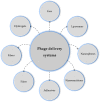Bacteriophages for Chronic Wound Treatment: from Traditional to Novel Delivery Systems
- PMID: 32093349
- PMCID: PMC7077204
- DOI: 10.3390/v12020235
Bacteriophages for Chronic Wound Treatment: from Traditional to Novel Delivery Systems
Abstract
The treatment and management of chronic wounds presents a massive financial burden for global health care systems, with significant and disturbing consequences for the patients affected. These wounds remain challenging to treat, reduce the patients' life quality, and are responsible for a high percentage of limb amputations and many premature deaths. The presence of bacterial biofilms hampers chronic wound therapy due to the high tolerance of biofilm cells to many first- and second-line antibiotics. Due to the appearance of antibiotic-resistant and multidrug-resistant pathogens in these types of wounds, the research for alternative and complementary therapeutic approaches has increased. Bacteriophage (phage) therapy, discovered in the early 1900s, has been revived in the last few decades due to its antibacterial efficacy against antibiotic-resistant clinical isolates. Its use in the treatment of non-healing wounds has shown promising outcomes. In this review, we focus on the societal problems of chronic wounds, describe both the history and ongoing clinical trials of chronic wound-related treatments, and also outline experiments carried out for efficacy evaluation with different phage-host systems using in vitro, ex vivo, and in vivo animal models. We also describe the modern and most recent delivery systems developed for the incorporation of phages for species-targeted antibacterial control while protecting them upon exposure to harsh conditions, increasing the shelf life and facilitating storage of phage-based products. In this review, we also highlight the advances in phage therapy regulation.
Keywords: bacteriophage; biofilms; chronic wound; delivery systems; phage therapy; wound healing.
Conflict of interest statement
The authors declare no conflict of interest.
Figures
References
Publication types
MeSH terms
Substances
LinkOut - more resources
Full Text Sources






